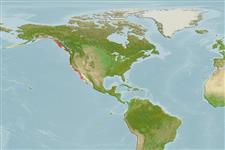Common names from other countries
Environment: milieu / climate zone / depth range / distribution range
экология
. Subtropical
Eastern Pacific: British Columbia, Canada to Mexico.
Length at first maturity / Size / Вес / Возраст
Maturity: Lm ? range ? - ? cm Max length : 3.0 cm SHD самец/пол неопределен; (Ref. 95344); common length : 2.5 cm TL самец/пол неопределен; (Ref. 312); наибольший возраст (опубликованны данные): 28 годы (Ref. 2823)
Shell is thick and dark purple to black; foot is black on the sides (Ref. 312).
It has a shell length of 2.5 cm. Fisheries: Over-harvesting for food in the early 1900s, mainly by Southern European immigrants, caused a drastic drop in population numbers. Today they are still harvested by both Americans of Southern European and Asian ancestries; heavy regulation by the Department of Fish and Game has allowed populations to recover (Ref. 312). Habitat: Occurs in high to middle intertidal zones on rocky surfaces or in pools not covered in algae. Diet: eats many species of algae including micro and macroscopic. Life span: up to 25 years (Ref. 312).
Life cycle and mating behavior
половая зрелость | размножение | нерест | икра | Fecundity | личинки
Members of the order Archaeogastropoda are mostly gonochoric and broadcast spawners. Life cycle: Embryos develop into planktonic trocophore larvae and later into juvenile veligers before becoming fully grown adults.
Основная ссылка
ссылки | координатор | соавторы
Gallivan, G. and J. Danforth. 1999. (Ref. 312)
Статус Красного Списка МСОП (Ref. 130435)
Статус СИТЕС (Ref. 108899)
Not Evaluated
Not Evaluated
Использование человеком
| FishSource |
инструменты
дополнительная информация
ресурсы в Интернет
Estimates based on models
Preferred temperature
(Ref.
115969): 9.5 - 17.9, mean 11.1 (based on 132 cells).
Категория цены
Unknown.
